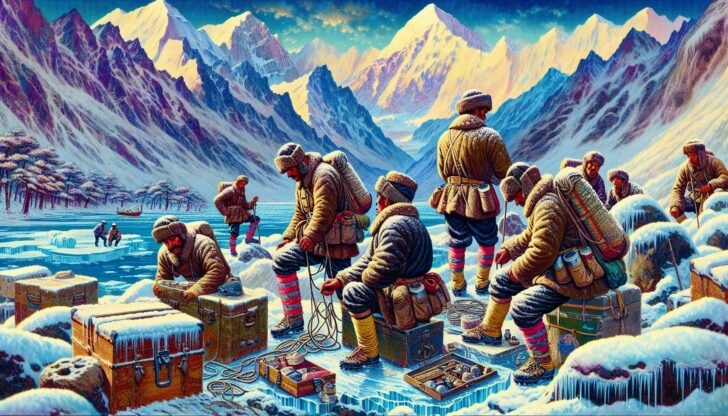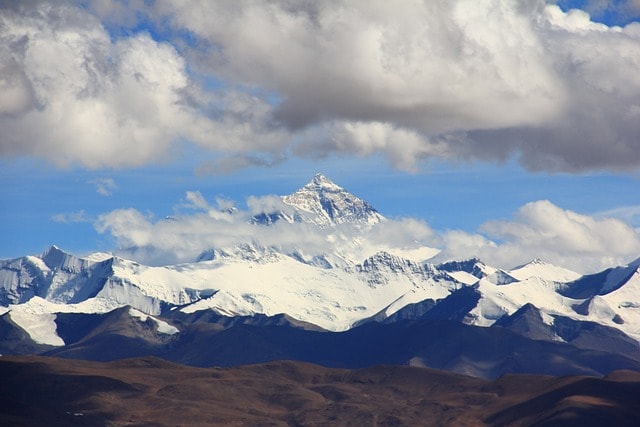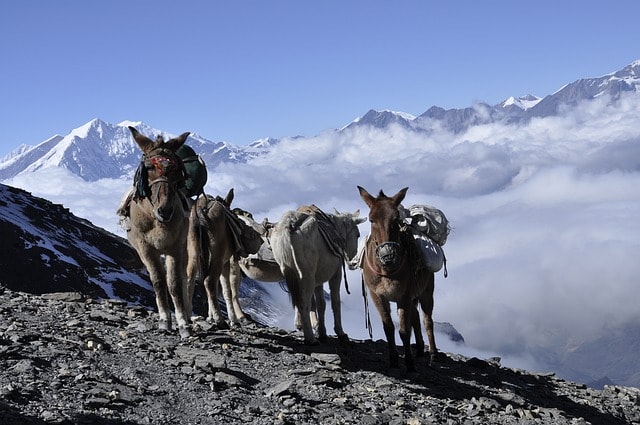Are you ready to explore the world’s tallest mountains? Himalaya mountaineering offers a blend of legendary history, cutting-edge climbing techniques, majestic peaks, and vital preparations. This guide covers everything from early expeditions to modern achievements, essential gear and strategies, impacts of climate change, and tips for planning your own Himalayan adventure.
Table of Contents
Key Takeaways
Himalayan mountaineering has a rich history marked by early expeditions and significant figures like Albert F. Mummery, laying foundations for modern climbing culture.
Technological advancements have transformed modern climbing techniques and equipment, enhancing safety and the chances of successful ascents in the challenging Himalayan environment.
Climate change poses significant risks to Himalayan mountaineering, necessitating conservation efforts and adaptations to climbing strategies to ensure the sustainability of expeditions.
The Origins of Himalayan Mountaineering

Himalayan mountaineering is more than just a sport; it is a testament to human ambition, resilience, and the relentless pursuit of the unknown. The history of Himalayan climbing is a rich tapestry woven with tales of courage, early expeditions, and pioneering climbers who dared to challenge the highest peaks on Earth, including those trained at the Himalayan mountaineering institute and Indian mountaineering.
It all began with the Great Trigonometrical Survey, which identified and measured some of the world’s tallest peaks, including the mighty Mount Everest, initially known as Peak XV.
Early Expeditions
The late 19th and early 20th centuries marked the birth of mountaineering expeditions in the Himalayas. Inspired by the discoveries of the Great Trigonometrical Survey, adventurous souls began to see the Himalayas as the ultimate frontier for high altitude climbing. These early attempts were fraught with challenges and often ended in failure, but they laid the groundwork for future successes.
Mount Everest, the highest mountain in the world, became a symbol of this relentless quest for exploration and conquest.
Pioneering Climbers
One of the most significant figures in early Himalayan climbing was Albert F. Mummery, who led an expedition to Nanga Parbat in 1895. Mummery’s attempt was marked by tragedy as he and two Gurkhas lost their lives, but his daring spirit and innovative approaches to high altitude climbing inspired many climbers who followed. His efforts showcased the immense challenges posed by the Himalayas and underscored the importance of technical skills and preparation.
Mummery’s legacy is a poignant reminder of the risks and rewards associated with Himalayan mountaineering. His expeditions, though often unsuccessful, highlighted the need for advancements in climbing techniques and equipment.
As more climbers were drawn to the Himalayas, the collective experiences of these early pioneers began to shape the evolving mountaineering culture.
The Everest Quest
The quest to summit Everest began in earnest in the 1920s, with expeditions that captured the world’s imagination. The 1924 expedition, led by George Mallory, ended in mystery and tragedy when Mallory and his climbing partner, Andrew Irvine, disappeared on the mountain. To this day, it remains a topic of debate whether they reached the summit before their untimely end.
The dream of conquering Everest was finally realized in 1953 when Sir Edmund Hillary and Tenzing Norgay achieved the first confirmed ascent of the world’s highest mountain. This historic climb not only cemented their names in mountaineering history but also sparked a global fascination with the Himalayas. Their successful ascent demonstrated the potential for human achievement in the face of seemingly insurmountable odds and inspired future generations of climbers to pursue their own Himalayan dreams.
Modern Himalayan Climbing Techniques

Himalayan climbing has undergone a remarkable transformation thanks to technological advancements and refined techniques. Modern mountaineering expeditions are now equipped with state-of-the-art gear that enhances safety and increases the chances of a successful ascent.
Lightweight materials and advanced oxygen systems have revolutionized how climbers tackle the majestic peaks of the Himalayas.
Equipment Innovations
The introduction of materials like Gore-Tex and carbon fiber has made climbing gear lighter and more durable than ever before. Innovations such as down jackets and advanced oxygen delivery systems have become essential for high altitude climbing, providing climbers with the necessary protection against extreme weather conditions and thin air.
Choosing equipment suited to specific climbing conditions is vital for expedition success.
Climbing Strategies
Fixed rope techniques and acclimatization methods are key strategies for modern Himalayan climbing. Fixed ropes provide stability and safety on steep, icy sections, reducing the risk of falls.
Acclimatization, achieved through staged ascents and the principle of climbing high and sleeping low, is critical for preventing altitude sickness and ensuring climbers are adequately prepared for the challenges ahead.
Learn more, checkout Types of Mountaineering and Common Climbing Techniques
Safety Measures
Safety is paramount in high altitude mountaineering. The use of supplemental oxygen is a critical measure to combat the effects of thin air above 8,000 meters. Climbers must also be aware of the risks posed by avalanches, falls, and extreme weather conditions.
Safety protocols like real-time weather monitoring and staged ascents mitigate dangers and improve the chances of a safe climb.
Major Peaks of the Himalayas
The Himalayas, spanning approximately 2,500 kilometers across Asia, are home to some of the world’s highest and most iconic peaks. From the towering Mount Everest to the formidable K2, these mountain ranges offer a range of climbing opportunities that attract adventurers from around the globe.
Each peak offers unique challenges, making the Himalayan peaks a diverse and thrilling destination for mountaineers.
Mount Everest
Mount Everest, standing at 8,848.86 meters (29,031.7 feet), is the crown jewel of the Himalayas and the ultimate goal for many climbers. The challenge of summiting Everest, with its extreme weather conditions, technical climbing difficulties, and risk of altitude sickness, draws experienced climbers from around the world. Notable figures like Kami Rita Sherpa, who holds the record for the most ascents, and Junko Tabei, the first woman to reach the summit, have left an indelible mark on Everest’s mountaineering history.
The perilous journey to Everest’s summit is powerfully motivated by the reward of standing atop the highest point on Earth. The Khumbu Icefall, notorious for its instability, and the demanding climb from base camp to the summit require climbers to be at the peak of their physical and mental capabilities.
The allure of Everest inspires climbers to push their limits and achieve greatness, despite the challenges.
K2 and Other Giants
K2, the second highest peak in the Himalayas at 8,611 meters (28,251 feet), is often considered more challenging than Everest due to its steep icy slopes and unpredictable weather. Other notable giants include Makalu, Lhotse, and Manaslu, each presenting unique hazards and demanding exceptional mountaineering skills.
Reinhold Messner’s ascent of all fourteen 8,000-meter peaks without supplemental oxygen testifies to human endurance and capability.
Beginner-Friendly Peaks
The Himalayas offer several peaks that are accessible to those new to high altitude climbing. Mera Peak, at 6,476 meters (21,247 feet), is the highest trekking peak in Nepal and offers stunning views of Everest and Kanchenjunga.
Island Peak, or Imja Tse, and Lobuche West are popular choices for novice climbers, with their relatively moderate difficulty levels making them ideal for gaining experience in the Himalayas.
Impact of Climate Change on Himalayan Mountaineering
Climate change poses a significant threat to the Himalayas and the future of mountaineering in the region. The extreme climate of the Himalayas has driven innovations in climbing techniques and gear, but the increasing number of climbers also raises concerns about overcrowding and its impact on safety and the environment.
Understanding these changes is crucial for ensuring the sustainability of mountaineering expeditions and the preservation of this unique landscape.
Melting Glaciers
The rapid retreat of glaciers in the Himalayas is a stark indicator of climate change. This phenomenon alters the landscape and creates hazardous conditions for climbers. The formation of glacial lakes and the increased instability of icefalls like the Khumbu Icefall pose significant risks.
Climbers must adapt their routes and strategies to navigate these challenging climb evolving dangers.
Weather Patterns
Shifting weather patterns in the Himalayas add another layer of complexity to climbing expeditions. The region’s unique geography creates highly unpredictable weather, with the southern slopes receiving heavy rainfall during the monsoon season while the northern slopes remain dry.
Managing the risks of these variable conditions requires real-time weather monitoring and adaptable planning.
Conservation Efforts
In response to the challenges posed by climate change, countries like Nepal are implementing conservation efforts to protect the Himalayas for future generations. Initiatives such as the Weather Adaptation Mitigation (WAM) and Waste Emissions Management (WEM) plans aim to achieve net zero emissions by 2045.
These efforts are crucial for preserving the natural beauty and ecological balance of the Himalayas.
The Cultural Significance of Himalaya Mountaineering

The Himalayas hold profound cultural and spiritual significance for local communities and climbers alike. Beyond the physical challenges, mountaineering in this region is deeply intertwined with the traditions, beliefs, and heritage of the people who call these mountains home.
This cultural richness adds a unique dimension to the mountaineering experience, making it a journey of both body and spirit.
Local Communities
The Sherpa community, renowned for their mountaineering expertise, plays an indispensable role in Himalayan expeditions. Their knowledge of the terrain and high-altitude climbing skills are invaluable to climbers aiming to conquer the highest peaks.
The Sherpas’ contributions go beyond guiding; they are the custodians of the region’s cultural heritage and help preserve the unique mountaineering culture.
Spiritual Journeys
For many climbers, the Himalayas represent more than just a physical challenge; they hold profound spiritual significance. Many peaks are considered sacred, believed to be the abodes of deities and spiritual beings. The act of climbing these majestic mountains is often viewed as a pilgrimage, a journey that transcends the physical realm and touches the soul. The serene beauty and tranquility of the Himalayas provide climbers with a sense of peace and a deeper connection to nature.
The spiritual aspect of Himalayan mountaineering adds a unique layer to the adventure. Climbers find themselves not only testing their endurance and skills but also exploring their inner selves. The mountains become a place of reflection and growth, where the journey to the summit mirrors the personal and spiritual ascension each climber experiences.
Mountaineering Culture
The culture of mountaineering in the Himalayas is marked by a strong sense of community and shared experiences. The challenges of high altitude climbing foster camaraderie among climbers, creating bonds that transcend nationalities and backgrounds. The collective spirit and stories from these expeditions inspire future generations of climbers and contribute to the global mountaineering culture.
This sense of community and mutual support is a defining feature of Himalayan expeditions, emphasizing the importance of teamwork and shared goals.
Preparing for Your Himalayan Expedition
Preparing for a Himalayan expedition requires meticulous planning and preparation. From physical training to gear selection and obtaining necessary permits, every detail must be carefully considered to ensure a successful and safe climb.
This section provides essential tips and guidance on how to prepare for the adventure of a lifetime.
Physical Training
Physical training is crucial for high altitude climbing. Climbers must develop their endurance, strength, and technical skills. Regular check-ins with climbing partners help monitor health and recognize early symptoms of altitude sickness, ensuring everyone is fit and ready for the challenges ahead.
Training should encompass rock climbing, ice climbing, and cardio exercises to build stamina and technical proficiency.
Gear Checklist
The right gear is essential for a successful Himalayan expedition. Layering clothing helps regulate body temperature in fluctuating weather conditions, while items like down jackets, sleeping bags, and advanced oxygen systems provide crucial protection against the elements.
A comprehensive gear checklist should include all necessary climbing hardware, communication devices, and emergency supplies to ensure climbers are prepared for any situation.
Permits and Logistics
Acquiring the appropriate permits is a vital step in planning a Himalayan expedition. Most climbs are scheduled either pre-monsoon (April to early June) or post-monsoon (late September to November) to avoid the heavy rainfall and unstable conditions of the monsoon season.
Logistical planning, including transportation, accommodation, and support staff, is essential for a smooth expedition.
Famous Himalayan Expeditions
Throughout the history of Himalayan mountaineering, numerous expeditions have left an indelible mark on the sport. From the first European expeditions in the 1920s to the modern-day achievements, these climbs have shaped the narrative of high altitude mountaineering and inspired countless adventurers.
Here, we highlight some of the most famous expeditions and the climbers who made them possible.
Historic Ascents
The first successful ascent of Mount Everest by Sir Edmund Hillary and Tenzing Norgay on May 29, 1953, remains one of the most iconic moments in mountaineering history. This achievement was followed by other historic ascents, such as the first American summit by James Whittaker in 1963 and the first female ascent by Junko Tabei in 1975. These milestones demonstrated the potential for human achievement and paved the way for future climbers.
In addition to Everest, other significant ascents include the first American traverse of Everest via the West Ridge by Thomas Hornbein and Willi Unsoeld in 1963. As of July 2022, a total of 6,098 individuals have reached the summit of Mount Everest, with a recorded 11,346 successful summits. Kami Rita Sherpa’s record-breaking 28 summits further exemplify the extraordinary feats achieved in Himalayan mountaineering.
Legendary Climbers
Legendary climbers like Gp Capt Jai Kishan have left a lasting legacy in the world of mountaineering. His successful ascents of Everest, Lhotse, and Mt. Cho Oyu, along with climbs of Mt. Denali and Mt. Aconcagua, have inspired many aspiring climbers to pursue their own high altitude adventures.
These climbers’ achievements showcase the dedication, skill, and perseverance needed to conquer the world’s highest peaks.
Modern Achievements
Modern achievements in Himalayan mountaineering continue to push the boundaries of what is possible. In 1980, Krzysztof Wielicki and Leszek Cichy made history by completing the first-ever winter ascent of Mount Everest. Such feats demonstrate the ongoing evolution of mountaineering skills and the indomitable spirit of climbers who continue to seek new challenges and break records.
Summary
The world of Himalayan mountaineering is a testament to the power of human ambition and the relentless pursuit of adventure. From the early expeditions and pioneering climbers to modern techniques and legendary summits, the Himalayas continue to inspire and challenge climbers from around the globe. As climate change reshapes the landscape and conservation efforts take center stage, the legacy of these majestic mountains endures. Whether driven by the thrill of the climb, the spiritual journey, or the sense of community, mountaineering in the Himalayas remains an unparalleled adventure. Embark on your own journey, embrace the challenges, and become part of the rich tapestry of Himalayan mountaineering.
Frequently Asked Questions
What are some beginner-friendly peaks in the Himalayas?
Mera Peak, Island Peak, and Lobuche West are excellent beginner-friendly peaks in the Himalayas, offering moderate difficulty levels ideal for novice climbers. Each of these peaks provides a rewarding experience with achievable climbing challenges.
How has climate change impacted Himalayan mountaineering?
Climate change has significantly impacted Himalayan mountaineering by causing rapid glacier retreat, increased icefall instability, and unpredictable weather, thus presenting new challenges for climbers.
What safety measures are essential for high altitude climbing?
Essential safety measures for high altitude climbing include using supplemental oxygen, monitoring weather conditions in real-time, and following acclimatization strategies like staged ascents and the practice of climbing high and sleeping low. Implementing these measures significantly enhances your safety on challenging climbs.
Who are some legendary climbers in Himalayan mountaineering history?
Legendary climbers in Himalayan mountaineering history include Sir Edmund Hillary, Tenzing Norgay, Junko Tabei, Kami Rita Sherpa, and Gp Capt Jai Kishan. Their remarkable achievements continue to inspire climbers worldwide.
What role do the Sherpa community play in Himalayan expeditions?
The Sherpa community plays a crucial role in Himalayan expeditions by offering expert guidance and support, utilizing their extensive knowledge of the terrain and high-altitude climbing. Their contributions are invaluable for the success and safety of climbers.









